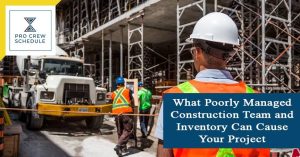Generally, there are two major assets that should be managed in a construction operation: people and inventory. While construction crew management involves scheduling, delegating, and constant supervision, inventory management requires much more.
In today’s article, we will discuss what poor construction team and inventory management can cause your project and how a construction management application can improve your current systems.
Let’s dive right into it.
I. Damage
When construction power tools malfunction, it can lead to a major risk to the person using it and other workers nearby. The hazards brought by defective power tools can impact workers on-site or even civilians who are just trying to do simple improvement work. A construction job scheduling software can help prevent damages from happening by conducting an in-depth review of the assets you’re going to buy, carefully picking out suppliers, and having regular maintenance— all scheduled on your calendar.
Some of the most common damages on construction sites are broken down below so you and your team can prevent them as your construction project progresses.
a. Manufacturing Defects
Sometimes construction power tools and equipment are safely designed, but problems related to manufacturing products can deem it to be unsafe. In these instances, an issue in the factory or manufacturing line is the reason for product problems, defects, and injuries to consumers.
A few examples of manufacturing defects are as follows:
- degraded or contaminated raw materials
- lack of quality assurance checking and testing
- negligence by assembly line workers
b. Design Defects
Problems related to design defects can be traced back to its initial development and creation. These construction tools and equipment are inherently dangerous since their design is unsafe. The company or manufacturer that made the tool may not have considered or chosen to ignore how a material might react under a certain stress level or how to minimize potential risks and injury. Furthermore, the product may not have been tested according to standards before it reached the market.
c. Defective Product Cases
Injuries that are caused by defective construction equipment and power tools are usually covered by legal damages to help cover medical expenses, lost wages, lost future earnings, physical rehabilitation, and even emotional pain and suffering. In some instances, punitive damages can also be awarded to punish the product’s maker or creator for negligence.
d. Electrocution Injuries
Apart from the design and manufacturing-related defects, there is also a risk of electrical burns and electrocution to keep in mind. Generally, poor wiring and frayed wirings could cause electricity to course through any person’s body, especially if there is no Personal Protective Equipment (PPE) to equip the worker. Electrocution injuries can majorly harm the nervous system, and a shock might even lead to cardiac arrest in severe cases.
e. Lacerations and Contusions
Cuts and bruises have always been common in construction, especially with power tools and heavy equipment. However, with the possibility of a defect, these simple wounds can cause serious damage. The lacerations may be severe, resulting in major blood loss, disfigurement, and nerve damage. The contusions sustained by an injured construction worker can also be serious, leading to head trauma, bone fractures, and brain injury.
f. Loss of Limbs or Extremities
Anyone who uses any cutting tools in their work must consider the high risk of amputation. This could mean the loss of toes, the loss of a limb, or the loss of fingers. The larger and heavier the construction equipment or power tool is, the bigger the risk of a catastrophic injury. The chance of successful reattachment of an injured extremity or limb can vary.
II. Failure
When you least expect it, a construction project is suddenly halted because a certain machine doesn’t operate properly. One of the worst parts is that putting a project at a standstill is the cost of money it will incur- not just a little, but mostly a lot. Research by Caterpillar discovered that unplanned downtime in a project could cost managers around 400 up to 800 non-productive hours per year, and that is just for one machine.
Besides the issue of machines being idle, lost hours in construction also mean a reduction in productivity. They can trigger injury claims if the equipment is faulty and injured operators bring about the delay. The most common heavy equipment failures occur with scrapers, forklifts, excavators, bulldozers, tractors, and more. Any tool or equipment in your inventory can break down and cause adverse effects on your construction site. This is why it’s critical to assign a day in your contractor scheduling software to conduct regular check-ups and maintenance to prevent failures.
Below is the most typical type of machinery failures that may encounter on a construction site:
a. Thermally-Induced Failures
As the name implies, these failures happen due to temperature changes. More specifically, they occur when there are significant temperature fluctuations. For example, when turning on a cold machine during the winter season, its temperature will rise quickly, which is bad for its engine. This big temperature difference can then contribute to the final breakdown of the machine.
Thermally-induced failures of heavy equipment can also happen if the machine gets too hot. If a construction machine operates in extreme heat conditions and weather, it can also overheat and eventually break down.
b. Mechanically-Induced Failures
The second category of construction equipment failures is known as mechanically-induced failures. These types of failures most frequently occur when the machine operators fail to maintain the mechanical parts of the machine properly. A few common reasons for mechanical failure are shock, collision, excessive or unusual vibrations, or overrunning the machines.
The only good part about mechanically-induced heavy equipment failures is that they are preventable and easy to avoid. Establishing a solid preventative maintenance plan is usually the key to preventing these mechanical breakdowns.
c. Erratic Failures
Of all the types of mechanical failures that you might encounter, erratic failures may be the worst kind on the list. It’s spontaneous so that your machinery can work perfectly one moment and then suddenly— stop. You won’t get any warning signs, there is no gradual slowdown, and there is absolutely nothing to tell you about something wrong with your machinery. These failures can randomly occur for multiple reasons, like an overload in your electrical system.
The main challenge about these failures is, unlike thermally-induced or mechanical failures, there isn’t much you or your construction team can do to prevent them from happening as they often manifest randomly. Fortunately, these types of failures are not a daily occurrence.
d. Intermittent Failure
This type of failure happens when a machine suddenly stops working and then, out of a sudden, starts working again. This common occurrence can be very frustrating to equipment operators. One moment you’re sure that the machine needs a technician, and the next moment it will be running swiftly again, without issues, making it difficult for technicians to detect the problem.
- Infant Mortality: accounts for around 68% of equipment failures
- – Random: accounts for around 14% of equipment failures
- Initial Break-In Period: accounts for around 7% of equipment failures
- Fatigue: accounts for around 5% of equipment failures
- Bathtub Curve: accounts for around 4% of equipment failures
- Wear Out: accounts for around 2% of equipment failures
III. Theft
As a contractor or subcontractor, you can expect many costs when building a construction project. Materials, permits, insurances, payroll, and other essential expenses are relatively simple to account for. Nevertheless, there is one highly expensive cost that is not so cut and dry- that is construction site theft.
Theft on construction sites is a serious problem and costs contractors and subcontractors a lot of money each year. Fortunately, current insurance policies can replace the cost of the stolen goods. Still, the reimbursement rarely accounts for the costs contractors need to pay due to the ripple effects brought about by construction site theft.
A few specific construction items tend to grow legs and often walk off job sites. Apart from the cost of materials skyrocketing, they appeal more to would-be thieves than others. In fact, sites like Facebook Marketplace, MaterialsXchange, and Craigslist, make great platforms for pawning stolen goods in a hurry. A construction job management software can help reduce construction theft as everyone on site will be informed on who is doing what at any given period.
Here are the three most typically stolen items from construction sites.
a. Construction Tools
Construction tools, particularly small power tools, are very easy to steal. They fit in jacket pockets, small bags, or even lunch boxes, making them very convenient to walk away with. And the online market is full of potential buyers looking for a discount.
b. Appliances
During the daytime, contractors and subcontractors install AC units, air handlers, water heaters, and furnaces in new buildings, leaving the job site empty at night. Thieves use this as a window to grab heaters, condensers, air handlers, and other appliances right off the site and then sell or reuse them on jobs they run.
c. Heavy Equipment
Heavy equipment is not as easy to steal as appliances or tools, but the profits for reselling excavators, backhoes, bulldozers, and others can be staggering. When these big-ticket items go missing off a construction site, the job can come to a screeching halt.
Key Takeaway
The possibility of theft, failure, and damage on construction sites is very alarming. It can be very costly, but we can intentionally reduce its possibility by establishing an effective plan integrated into an online construction management software.
Platforms like Pro Crew Schedule can help with the construction schedule and inventory management by improving remote monitoring of your schedule and assets and allowing for various service or maintenance requests straight from the job site.
Depending on online failure to help with these risks makes sense.







